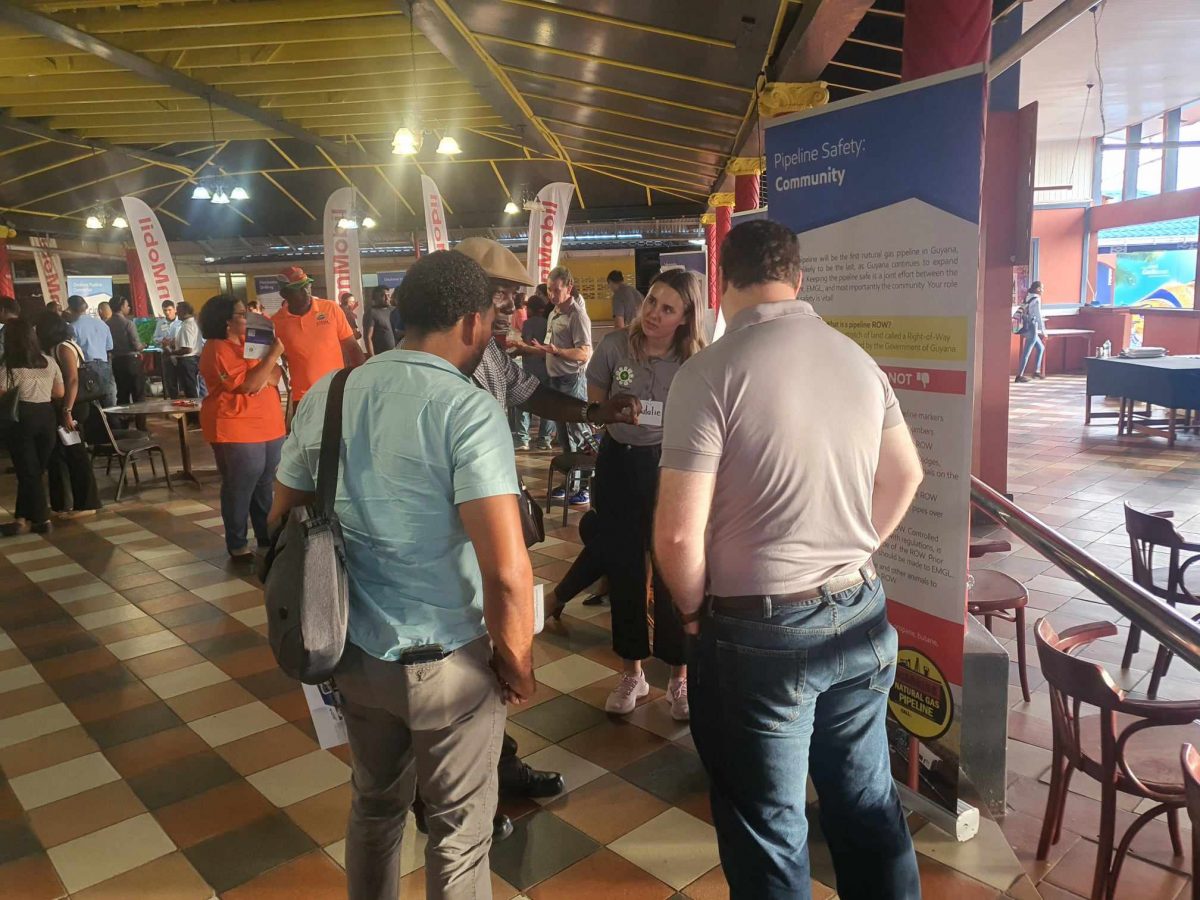ExxonMobil on Tuesday continued its community outreaches in Region Three with an open house event to engage and field questions from residents on the huge and controversial gas-to-energy (GtE) project.
Held at the Aracari Resort, Versailles, West Bank Demerara, the event saw a number of persons in attendance who were curious about not only what the project entailed, but the employment and other opportunities the project could offer.
“I live at Vriesland and farm and have cattle there. My concern was that we were hearing that (there is) going to be flaring (of gas at) the plant and the heat would burn and destroy the crops and was not good also for the cattle…,” resident Ivor Charles told Stabroek News.
“My brother is the one that told me I should come and I am glad I made the effort and did. They answered the questions and said, nah, there won’t be any flaring and the things them safe…,” he added.
For Crane resident, Gaitree Mahadeo, she visited on her way home from work because she wanted to know if there was any truth to the rumour that when it rains the gas pipes would be exposed and could pose a danger. “I live right where the pipe running and my daughter tell me come and complain. I didn’t have a chance before because of how I work but I want them to answer if them go break up the road and then when rain fall the pipe go bring more problems….”
Asked if the answers given to her were satisfactory, she responded, “Not really sure but I will show meh daughter these papers and she will explain the whole thing better. I just don’t want them break up the good roads and then [leave] them with the pipe expose and next thing is flood out or somebody light rubbish and is one boom! Gas is not something easy.”
Around the hotel’s auditorium, the company had stations where persons explained different aspects of the project. They also explained that there is a community outreach team led by a Natasha that goes into the villages in Region Three and meets with residents.
All of the open house feedback sheets received on Tuesday will be looked at and be addressed by contacting the persons individually. The information would also be used when another event is hosted during the course of this year.
The feedback sheet asks, among a list of questions, if the company answered the questions residents had sought clarity on, and what else they needed to know if it was not. They are also asked what they want to see at the next GTE Open House, and why they came to the event.
There was also a trivia competition where persons won prizes ranging from bags, water bottles, umbrellas, and key chains.
The company had also planned to hold Tuesday’s event at one of the schools in the region but had to change plans because of the Guyana Teachers’ Union strike.
Meanwhile, among pipeline safety plans, residents were told that after the pipeline becomes operational, ExxonMobil Guyana Ltd (EMGL) will utilise various methods to proactively respond to possible integrity issues in its systems before safety and environmental performance is compromised.
Aerial
“Aerial and ground bases inspectors will regularly monitor the pipeline route for potential integrity issues including, but not limited to visible changes to the soil and vegetation that may indicate a leak, unauthorized access or activities or obstructions that could affect maintenance, inspection or repair operations, and depth of cover,” the company explained.
ExxonMobil says that the natural gas pipeline project is the first of its kind here, “but is unlikely to be the last, as Guyana continues to expand its economy.”
It was highlighted that community was important to EMGL and as such, it is pleading with persons to get engaged.
“At EMGL, we believe in continuous engagement with the community to answer questions and address concerns. We welcome you to utilize our Community Grievance Mechanism (CGM) to raise concerns directly to EMGL and have them addressed in a prompt and respectful manner,” the pamphlet states. It lists a 623-1176 telephone number and an email address, guyanancommunity@exxonmobil.com to contact for complaints and concerns.
The company lists a number of Do’s and Don’ts. Among the Do’s are for persons to respect the Right of Way (ROW), the narrow stretch of line which the pipeline follows. It also asks that they look for signs and pipeline markers, call the emergency numbers if there is an emergency, warm others of the presence of a gas line in the area and to report any strange activity near or on the ROW to EMGL.
The Don’ts are that persons not remove signs or pipeline markers, prank call emergency numbers, plough, dig or flood the ROW, build or erect structures, bridges, pathways, or stockpile materials on the ROW. They should also not run cables or drainage pipes over the ROW or burn within the ROW or allow their cattle or other animals to graze on the ROW.
The GtE project is divided into three components – Pipeline, Power/NGL (Natural Gas Liquids) Plant and Transmission Line/Substations. The Pipeline component includes a 250 km 12” pipeline from two Floating Production, Storage and Offloading platforms (FPSOs) to deliver some 50 MCF/D (1,000 cubic feet per day) of gas to shore, although the pipeline has the capacity for 120-plus MCF/D. The Power/NGL Plant component is the 300 MW Combined Cycle and NGL Facility while Component 3 will have Transmission Line/Substations of 85 km of 230 & 69 KV Transmission Lines, 3 new substations, and upgrades to 2 other sub-stations.
The pipeline aspect is anticipated to be completed between October and December of this year.






